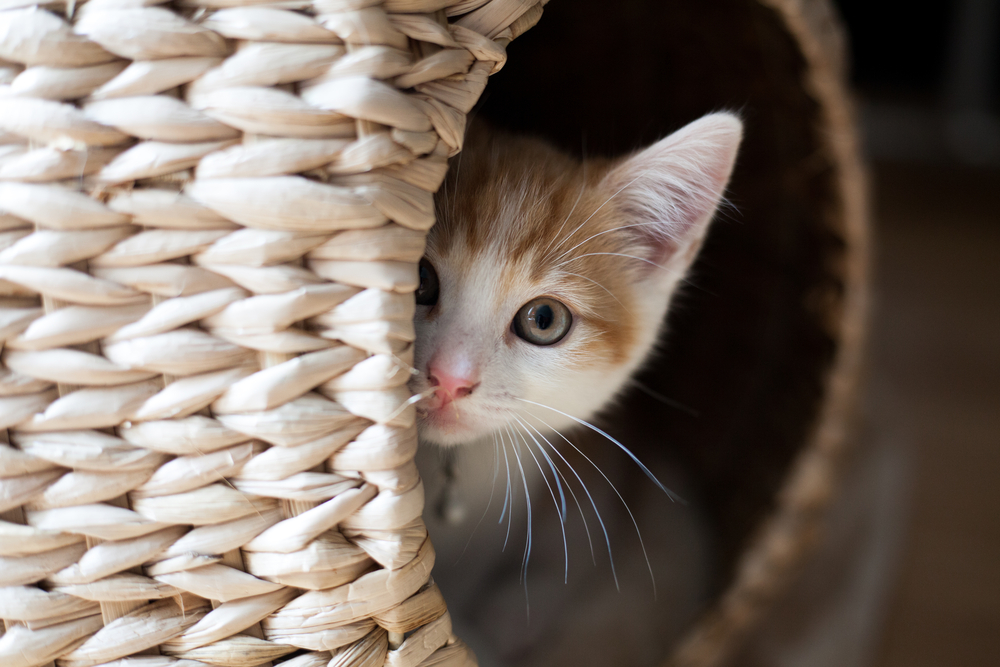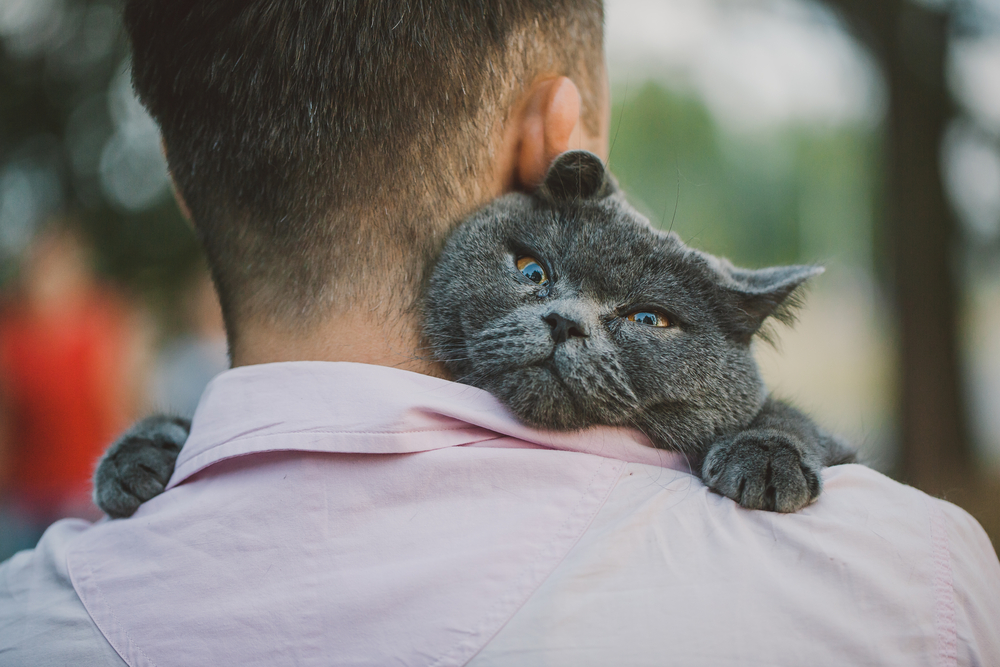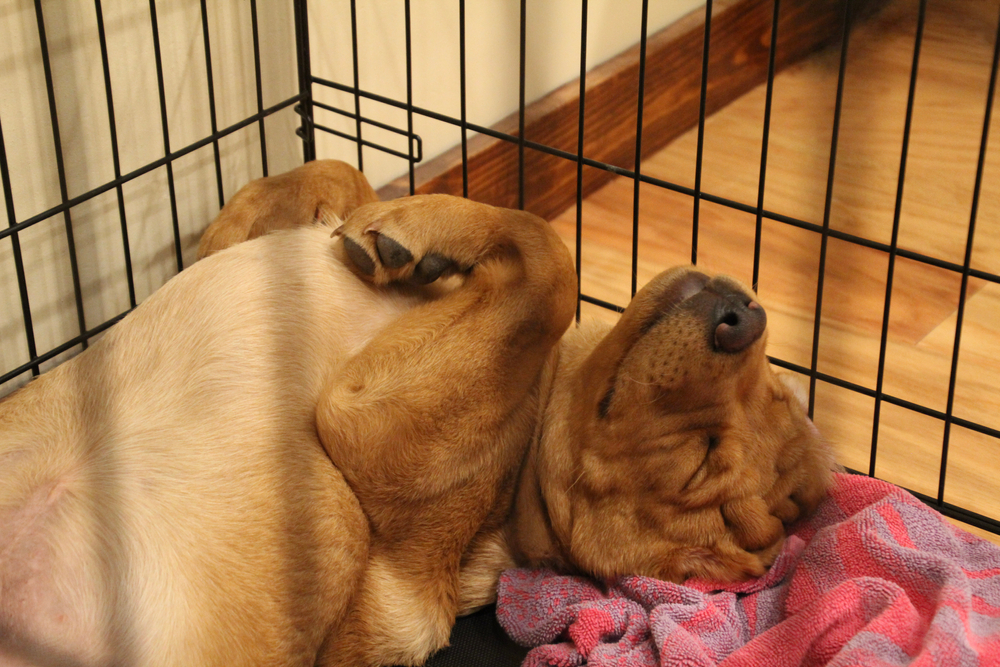Have you ever arrived home from work to find the dreaded note on your door regarding your barking dog? Do you receive side-eye from the neighbors while your pup is in the yard barking like a madman through the fence? Ever had warnings from postal carriers and delivery folks that they refuse to come near your front porch due to your barking pooch? If your answer is “yes” to any of these — your dog might have a barking problem!
Excessive barking is a common issue that causes strain on the dog/pet parent bond and often creates uncomfortable conflict with neighbors. Sadly, barking can also contribute to the difficult decision for pet parents to re-home or relinquish their dogs.
While barking is actually a normal and natural behavior that we humans selectively bred into modern dogs (wolves rarely make many sounds!), sometimes your dog’s barking can get out of control. In some cases, barking can even indicate a health issue! Let’s explore the motivations behind excessive barking and discover what your pup may be expressing through their vocalization. We will also look into some possible approaches to bring peace back into your household.
Barking as a Natural Behavior
Everyday life contains many triggers for a dog to bark. Believe it or not, when she loses her marbles over the postal worker’s daily visit and vocalizes to get your attention, your dog is actually exhibiting normal instinctive behaviors. Some of the most common motivations behind barking are also related to a dog’s innate drive to protect their territory and to warn others to stay away. Your dog may also learn that barking will gain attention from family members or other animal buddies. Some dogs have figured out that even more barking gets the immediate reaction they seek! Does your dog go ballistic when the doorbell rings? Yep, they’ll bark in response to different sounds and stimuli, too.
How do you distinguish instinctual/learned behaviors versus a health problem that may be causing your dog to bark? Here are some clues:
-Is your dog genetically programmed to be vocal? (guarding breeds, small breeds, etc)
-How do you respond to your dog’s barking — Do you yell back (viewed by your dog as “joining in” his mission)? Do you pacify them immediately and provide what they are seeking (positively reinforcing the behavior)?
-While they’re barking, do you give your dog a treat/favorite chew in order to silence them (more positive reinforcement and reward for the behavior)?
-Does your dog view his barking as a success (does he “chase” postal workers away every day)?
-Do you have multiple dogs that feed off of each other and rile each other up?
-Does the barking happen when you are home? Is it predictable at certain times during the day? In response to an outside stimulus or sound?
If any of the above describes your pooch, then guess what? Your dog has learned that his barking is successful and possibly even appreciated by you, even though you may feel otherwise!
Although these behaviors are undesirable, they are in fact pretty normal but exaggerated ways for dogs to communicate their wishes and feelings. It is also very important to identify when instinctual barking may have been positively reinforced–usually unintentionally–by pet parents and family members. Treatment/rehabilitation for this type of barking is approached very differently than barking caused by a health issue. However, just because you’ve got a dog that has learned that his barking achieves desired results does not mean you are doomed to be irritated by it forever!
Barking Due to a Health Issue
If the above descriptions don’t quite fit your pup, consider that his vocalization may indicate that a mental or physical health issue could be the root cause. If they do not bark when you are at home, but they fall to pieces shortly after you leave the house, they may be experiencing separation anxiety. Dogs with separation anxiety as well as phobias to storms and noises will panic and bark excessively due to the anxiety and fear that they are feeling.
Also, dogs in pain and distress may bark, especially older dogs that may be experiencing cognitive decline (kind of like dementia). When these senior pups become more confused, uncomfortable, and disoriented, it is natural for them to “seek help” by barking.
Sometimes dogs will bark due to a combination of things too. Careful observation of the circumstances that prompt your dog to bark excessively will be very helpful to your veterinarian, board-certified veterinary behaviorist, or certified trainer who you’ve enlisted to help. The approach to barking caused by mental and physical health issues aims to target the underlying medical condition, as opposed to just the behavior of barking itself. It is very important to know the context surrounding the excessive barking at home so your veterinarian can critically examine the situation and tailor the treatments appropriately.
Treatments for Barking
Thankfully, although most dogs do bark, it does not typically occur often enough to create a serious disturbance. However, unrestrained chronic barking can really disrupt the peace of your home and your relationships with the neighbors–and imagine the stress your pup might be enduring if there is a mental issue at play!
Socialization
Puppy Training and socialization can be a game-changer to prevent issues like barking from the get-go! Excessive barking can be avoided altogether if a puppy is socialized thoroughly. What does thorough socialization entail? We’re glad you asked!
Socialization means that, at a young age, your pup is introduced with positive reinforcement to diverse situations, people, and dogs. Crate training a puppy can help with confidence and teach them to feel secure even when home alone. Teaching basic commands and behavior techniques also creates a well-balanced adult dog. For pet parents, learning how to respond calmly and appropriately to puppy behaviors is important, and can be learned from trainers and fear-free training books. Teaching a puppy to learn to focus their attention on you when they are aroused or excited and to learn that treats are given for calm and quiet behavior, will help prevent barking issues and even provide an easier time if/when any bothersome behaviors do need to be addressed.
Alas though, if your pooch is past the puppy period you’ve got some work to do! In general, punishment (like spraying with water, etc) for barking is rarely successful nor encouraged, and can even cause your dog to feel confused or fearful. Especially true for dogs that bark due to everyday stimuli (guarding, postal workers, folks walking by, genetics) the best outcome is usually achieved with positive reinforcement for good quiet behavior and desensitization to the stimulus.
It is important to distinguish the motivation and triggers behind the constant barking before you start to consider what treatments may be successful. Here are some common approaches to consider if barking in your home has gotten out of control.
Bark Collars–and Why They Don’t Work
There are a variety of bark-activated, punishment-based, barking deterrents and collars on the market. They range from giving a little electric “zap”, noise, or puff of citronella in order to discourage the barking behavior. Some pet parents can see improvement with these products. However, dogs often learn to avoid the punishment delivered by the collar. For example, they will learn to turn their heads to dodge the puff of citronella or once they get used to the deterrent, they will just bark right on through the annoyance. They also quickly learn that they can freely bark like crazy when the bark collar is off. After all, your dog is no dummy!
Since these deterrent devices can be activated by another dog’s bark, they’re not an option for dogs in multi-dog households. Worst of all, deterrent collars can make a stressed and anxiety-ridden pup much worse since they are now being negatively punished for their fear while their pet parent is gone. Can you imagine someone punishing you for being scared? Would that make you more or less frightened?!
Muzzles are a No-No Too
Some pet parents ask, “why can’t I just put a muzzle on my dog to stop the barking?” The use of nylon muzzles or metal/plastic basket muzzles are not recommended under any circumstances to control barking. Muzzles are not intended for this purpose, can be dangerous if used for extended periods of time, and are not to be used if the muzzled dog is left unattended. If your dog vomits while wearing a muzzle, he could inhale his vomit and develop pneumonia–or worse. If he is unable to pant over a long period of time due to the restrictive muzzle, he could also be in danger. Muzzles are a valuable tool in some circumstances–but NOT for stopping a dog from barking.
So…What DOES Work? Desensitization, Positive Reinforcement, and Training!
Desensitization is when your dog is repeatedly exposed to a stimulus (like someone approaching the door) slowly and in a controlled manner, so as to not trigger their typical emotional response. The goal is for your dog over time to become less sensitive and emotional to the stimulus. How does this happen? By repeatedly re-creating your dog’s favorite barking triggers, and making those triggers into a complete non-event. When a visitor to your door “means nothing” to your dog, they will be more relaxed and less inclined to bark to protect the home. Even better, you can turn it into a positive event (see below)!
AskVet Tip: You may want to enlist the help of a friend or family member with this type of exercise! As someone approaches the door, ignore your dog’s barking but hang out nearby with some treats at the ready. Once they finally stop barking (they usually will pause or take a break), or “sit” on your command, toss a favorite treat in their direction. Repeating this over and over (even dozens of times, days in a row!) will eventually train your dog that he gets rewarded for calm behavior.
It’s important that when your dog DOES bark instead of sitting quietly, he is IGNORED. As we discussed, punishment only amplifies the emotion your dog is feeling about a particular situation. Do not yell at your dog, raise your voice, spray them with a water bottle, or anything else to punish him. Rather, IGNORE him and as soon as he calms down, toss a treat his way! Reward the behavior you want, and ignore the behavior you don’t. Never reward a dog that is actively barking by giving them a treat or the attention they are seeking, as this will inadvertently encourage the behavior that landed you here in the first place.
Counterconditioning is the other side of the psychological coin: associating a troublesome trigger with a positive experience. This replaces the negative behavior with positive emotions and encourages the desired response from your pup. For example, some postal workers have figured out a strategy to come to the house bearing dog treats, encouraging your dog to welcome them to the porch as a friend and not a foe!
Both counterconditioning and desensitization techniques take time and patience and require repetition, praise and rewards for positive desired behavior. Training and behavior modification does not occur overnight, and constantly repeating these practices is necessary. All of your hard work will pay off over time–we promise!
Utilize Appropriate Behavior Resources, Books, and Certified Trainers
To ensure that you are not confusing your dog by sending mixed signals or missing opportunities to reinforce the behavior you want, reading a well-regarded training book is recommended–we like books by Dr. Sophia Yin, a board-certified veterinary behaviorist, and Dr. Patricia McConnell, an animal behaviorist. Resources (blogs, and videos included) from either of these professionals will help you achieve the most speedy and sustained changes in your dog’s behavior.
Consulting a certified dog trainer in your home and seeing them in action with your dog is a great way to gain some tips and tricks for altering your pup’s behavior, and for altering your own response. The trainer may be able to advise on techniques including training your dog to bark on a verbal cue (“speak” or “bark”), and then stop with a command (“quiet” or “silent”). Sometimes, this simple trick can resolve most of a dog’s troublesome barking–since they realize they are only supposed to bark when commanded to do so! A trainer can also share pointers for training a dog to go to a specific location in your home on command, distracting your dog, and stopping the barking behavior in its tracks.
Avoiding the Stimulus
Using avoidance measures to dodge the stimulus and redirect a dog’s attention are also management strategies to ditch the bark-fest. These techniques are very successful if the triggers are known or fairly regular.
Distraction with an engaging toy or chew treat prior to the start of the stimulus will provide a more pleasant alternative to barking and keep your dog’s attention away from the trigger. (This is another exercise that a friend can help you with!) For example, if your dog barks at the door after you leave the house, give her an engaging toy or treat before you start to get ready to leave. By the time you slip out the door, your dog won’t even notice!
If your dog is barking at objects and people outside, try installing or pulling down window shades, moving furniture to eliminate a dog’s favored post at the window, fixing any holes in your home’s fencing, or providing solid outdoor walls instead of gates to help your pup avoid any eye contact with one of his “threats.” Better yet, keeping your pup in a different part of the house during problematic times of day (such as when the postal worker comes by your house, or when the garbage truck is in the street) will ensure your dog will not even know what he is missing! Separating dogs from their stimulus BEFORE they lose their marbles can take some careful attention from the pet parent, but often peace for dog and human can be achieved.
Veterinary Care, Anxiety Medication, and Support for Cognitive Decline
If your dog is exhibiting signs of separation anxiety, cognitive changes due to aging, or an uncharacteristic increase in barking behavior, it is recommended to have your dog examined by your veterinarian. Blood and urine testing may be suggested to rule out any issues with internal organ function, and x-rays may be needed to check bone and joint health. An in-depth discussion with your vet about the behavior your pup is exhibiting at home will help identify if there is a medical problem at play. A full report of when, why, who, how long, and describing your typical response to your dog’s behavior is very helpful to your veterinarian. Feel free to bring in some notes with your observations. Videos of the events are invaluable too!
In cases where an anxiety disorder is suspected, your veterinarian may recommend combining the talents of a veterinary behaviorist or certified dog trainer with some antidepressant and anxiety medication. This combined approach can help your dog calm down so they can become receptive to coping mechanisms and learn to be less afraid. Medication plus behavior modification training can work wonders for dogs with anxiety and fear-based barking behavior. Like all behavior modification though, it takes time, consistency, and patience for the medications to take full effect and learning to begin.
Cognitive changes (similar to dementia) causing barking in senior dogs can be addressed with supplements, medications, diet changes, and environmental support to help them feel more secure and to calm their aging minds. Unfortunately, there is no specific treatment or cure for Canine Cognitive Dysfunction Syndrome, but your veterinarian will take into account the behaviors you are seeing and suggest a treatment plan to try at home in order to bring comfort to your dog.
Daycare and Dog sitters
If all else fails, or maybe you’re not even a fan of your pup home alone, the chances that you have a doggie daycare or local dog sitter/walker in your town are pretty high these days! These businesses exist for the care and entertainment of dogs while working pet parents are out for the day. For pups who are struggling with barking, a day spent playing and expending energy can help calm them down and make life at home more peaceful. This is especially true for dogs who do well in groups, who have anxiety about being left alone, or who are very high energy and benefit from extra playtime.
Silencing the Bark
Thankfully, we have several effective options to choose from if your pup has decided that barking like crazy fulfills his needs. As you might expect, none of these courses of action result in immediate improvement–they require patience, repetition, and consistency. Although it can get frustrating at times, remember that YOU are your dog’s best friend and the best person to help him through this process.
Take the time to thoughtfully address your pup’s entire family so that everyone is onboard — especially when it comes to treats, attention, and training goals. Armed with knowledge, actions, toys, and treats you can get that barking under control and establish peace in your home and neighborhood.
Our AskVet Veterinarians are available to discuss all of your pet’s needs 24 hours a day, 7 days a week. Whether you have an immediate need to address excessive barking or are looking to improve your pet’s overall wellbeing, just sign into your account and one of our friendly and knowledgeable veterinary experts will attend to your needs, no appointment required!
Written by:
Alexa Waltz, DVM
Dr. Waltz was raised near the beaches of Southern California but has spent her adult life living all over the beautiful United States while serving in the military and as a military spouse. She left California for the first time to pursue a career as a veterinarian at Louisiana State University School of Veterinary Medicine and graduated as a Doctor of Veterinary Medicine in 2006. She was accepted into the US Army Health Professionals Scholarship Program during vet school and upon graduation spent her military years as a veterinarian in San Diego working for the US Marine Corps and US Navy Military Working Dog programs as well as caring for pets of service members. After her military service, she became a civilian veterinarian and continued as a small animal general practitioner at clinics in California, Rhode Island, Colorado, and Maryland. Dr Waltz loves to see her “in person” patients just as much as communicating with and assisting pet parents virtually on AskVet. Dr Waltz is also a Mom to 3 humans, 2 guinea pigs, and 1 Australian Shepherd and in her spare time she loves traveling, adventures, exercising, and doing just about anything out in nature!










